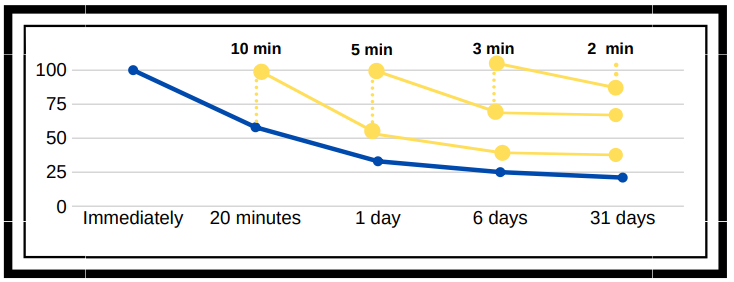Sign-up at least 14 days before your exam (applies to all timed assessments)
 Learning Guide: Learning & Memory
Learning Guide: Learning & Memory
Many different variables impact your ability to learn and to remember. People learn new material best when they encounter it multiple times and through multiple means. Use the information and strategies below to help retain what you learn for longer.
The Forgetting Curve
We hold on to information longer when we have encountered that information multiple times in different ways. The forgetting curve explains how our brains hold on to or let go of what we learn.

Our brain remembers 100% of what we have learned immediately following a lecture or learning period. Within 20 minutes, we forget almost 50% of what we learned! After one day, we remember 33%. After six days, we retain about 25%. This pattern of forgetting continues until you have lost everything.
To be ready for final exams, this means you must reteach yourself any material you learned earlier in the semester.
Review Your Material
We can interrupt the forgetting process by going back to our material on a regular basis. It only takes a 10-minute review about 20 minutes after class ends to bring our memory back to 100%. One day later, it only takes a 5-minute review to bring back 100% of our memory. Six days later it only takes 3 minutes of review, and one month later it only takes 2 minutes!
Reviewing material on a consistent basis makes it easier to commit long-term memory, and it will take you less time to study before exams.
Retrieval Practice
Retrieval practice is a way to strengthen memory by deliberately trying to recall what you learned. Instead of simply reviewing content, you use various study exercises to retrieve that information from your brain. Why does it work? It allows you to move what you’ve learned into long-term memory. It also strengthens neural pathways and makes it easier to find information when you need it later (for example, during an exam).
5 Keys to Retrieval Practice
- Reflection: Look back on what you've learned.
- Generation: Try to answer a question before a solution is provided.
- Mnemonic Devices: Link new information to a familiar structure.
- Elaboration: Connect new information to existing information - from this class, from another class, from life.
- Calibration: Quizzing allows you to get a real idea of what you know or don't know.
►Access the ![]() Retrieval Practice PDF.
Retrieval Practice PDF.
Tips for Effective Retrieval Practice
- Space out your practice.
- Use multiple means to access information (for example, try a “brain dump” and write down as much content as you can remember).
- Draw connections between what you’re learning.
- Study in a way that is challenging and effortful.
Retrieval practice is only helpful if you already have a good understanding of the material. You need to understand what you are learning first before you can practice recalling that information from memory.
Apps for Retrieval Practice
Watch our Learning and Memory webinar to learn about:
- Retrieval practice and the 4 keys of this practice
- Study strategies and how to practice recalling information
- Potential barriers to learning and strategies for overcoming them
Your Study Environment
Your study environment has a huge impact on your ability to stay focused and get work done. When preparing your study space, ask yourself:
- What distractions are present?
- What do I need in order to maintain focus?
- Are there ways I can use my sensory memory to my advantage?
- What time of day do I work best?
Go through each of your senses to determine what needs to change to minimize distractions and increase focus. The result will be a study environment that fosters success!
► Access the Your Study Environment PDF
Resources for Effective Studying
- The Stress Curve (PDF)
- 5 Keys to Retrieval Practice (PDF)
- Your Study Environment (PDF)
- Studying 101: Managing Distractions (PDF postcard)*
- Studying 101: Optimizing Your Concentration (PDF postcard)*
- Studying 101: Enhance Your Learning (PDF postcard)*
- Learning Tip: Preparing for Your Class (PDF postcard)*
- Make It Stick (by Brown, Roediger & McDaniel)
- Teach Yourself How to Learn (by McGuire)
- Working in Groups (video by UBC)
- The Surprising Link Between Stress and Memory (Video by TED-Ed)
* Access the screen-reader compatible version of our postcards' content.